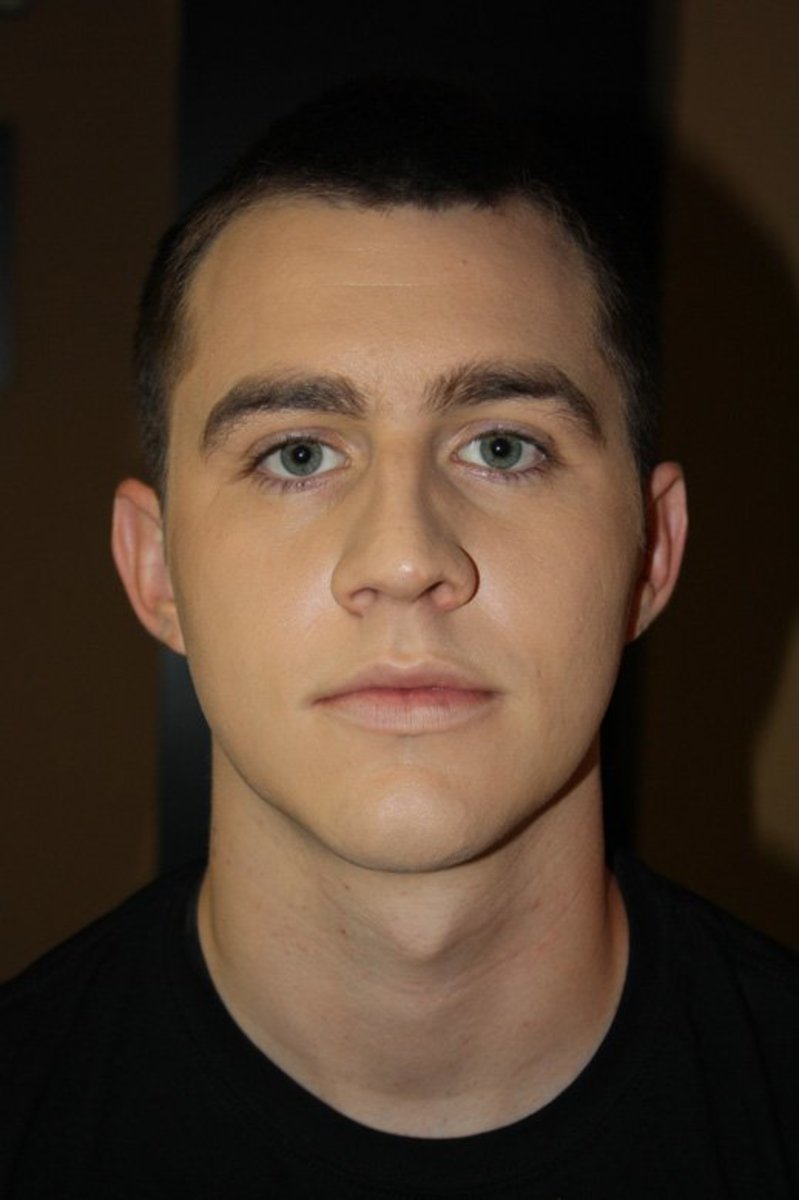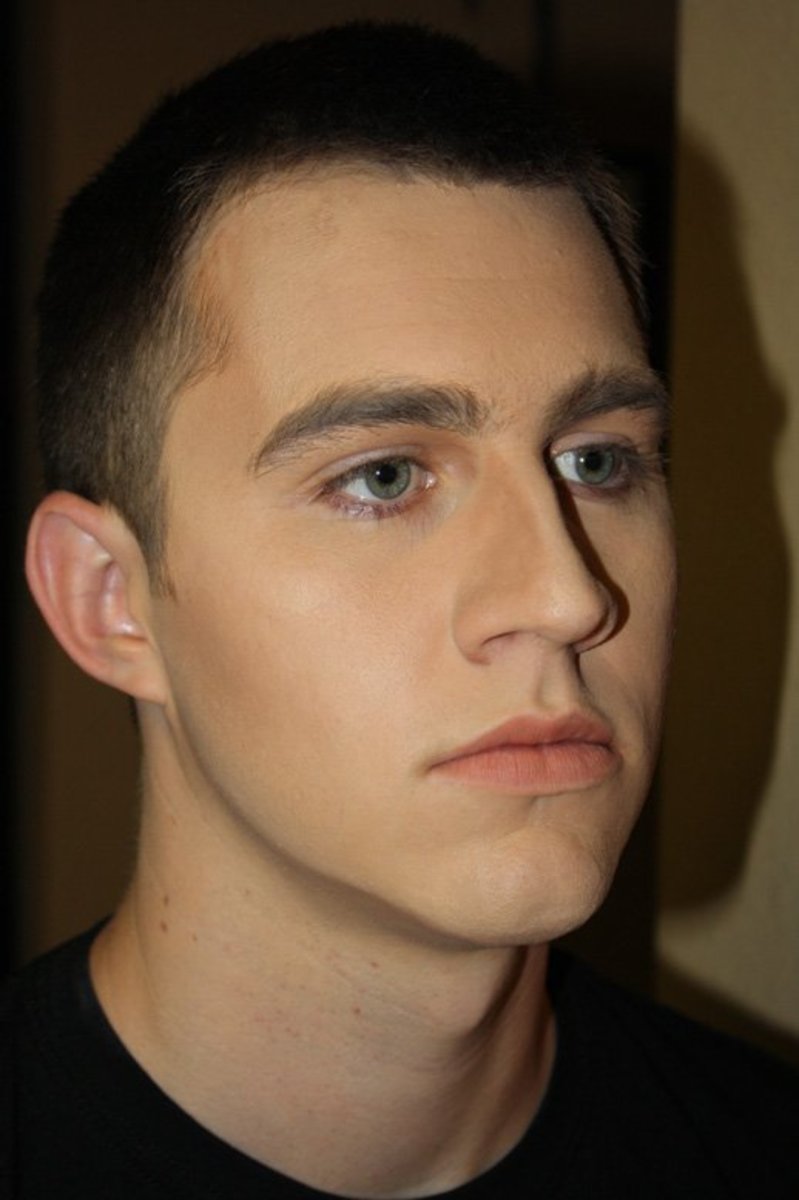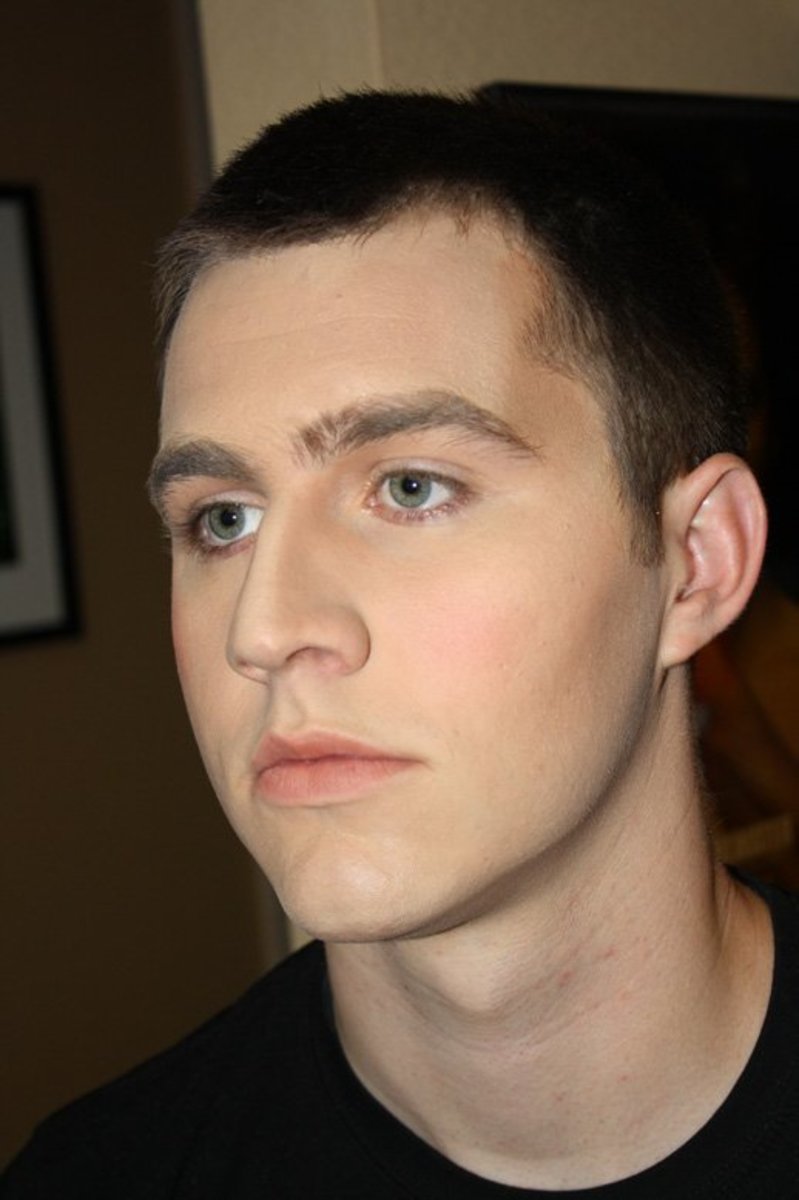Types of Makeup

There are three kinds of makeup artists: straight makeup, sometimes called "street," which enhances an actor's features using cosmetics and corrective makeup; character makeup, which transforms an actor through facial prosthesis and other devices; and special effects (FX) makeup, employing mechanical devices such as robotic inserts. All three work closely with the director, cinematographer, and costume designer. Incorporating these three divisions, makeup's complex work can be loosely broken into the two categories of cosmetics and special effects. The former also radicalized the cosmetics industry. Often the two merge, but the makeup industry began with the need to accentuate the face and to deal with the drastic differences between stage and cinema.
Straight Makeup
Stage and studio lighting tend to be stronger than natural light and comes from several angles. This tends to erase the natural shadows and flatten out the face. With make up, facial highlights and shadows are re-created so that lighting cannot erase them. Depending on the size of the theater and how far the actor is from the audience determines how strong these highlights/shadows need to be. The makeup in this tutorial is sufficient for film or a smaller theater.
Before You Begin
Make sure the actor's face is clean and shaven. I used Ben Nye cream makeup for this. You need a foundation that is a shade or two darker that the actors skin color because the lighting will usually make the face appear lighter. The highlights need to be a shade or two lighter than the foundation and the shadows need to be a shade or two darker. Make sure the highlight and shadows you use are equidistant from the shade of the foundation.

Foundation
Start by applying foundation with a makeup sponge to the entire face and on the neck. Be sure to get the eyes and the lips. The foundation is important because the highlights and shadows need something to blend into and it wont blend into your skin alone.

Highlights and Shadows
Start by blocking in the highlights and shadows. First we'll highlight all the high points of the face where natural light hits. Paint a line of the highlight across the top of the forehead starting from the center and move outward. These should be one stroke each. Paint a line on the temple bone on either side of the forehead, and another right above the eyebrows starting from the outside and brush inwards. Add another line on the nose starting from the top of the tip and brush upwards. Feel for your cheekbones and paint a line along the top of them starting from the hairline and brush inwards. Then paint a line along the jawbone.
Next grab your shadow color and paint lines on the outside of the temple highlights, the nose highlight and right below the jawline. Add a shadow on the bottom of each cheekbone as well.

Blending
Now you need to blend the highlights and shadows into the foundation. I find it easier using my fingers. Blend the highlight along the hairline downwards on the forehead and the ones above the eyebrows blend upwards. The temple highlights get blended inwards. The cheekbone highlights blend upwards as well as the jawbone highlight. The nose highlight blends upward and the shadows blend outward. The temple shadows blend downwards as do the cheek shadows and the jaw shadows.

Eyes and Lips
The eyes get shadowed right below the eyebrows on the inside and get blended outward. The eyelids get highlighted in the center. With a dark brown eyeliner or small brush, line the eyes lightly on the bottom and a little on top. Next paint the lips with a color as close to the natural lip hue but a shade or two darker.

Once finished, powder over the entire face and neck to keep from smearing. Now apply powdered rouge or blush lightly on the cheeks between the highlight and shadow to put color back into the face.
Special Effect Makeup
What is Special Effects Makeup?
First of all, let’s get a few definitions out of the way. SFX makeup artists use make-up and prosthetics to give performers abrasions, wounds, deformities, animal features: you name it! They can make an actor look slightly older—or create an otherworldly monster.
Some famous examples include Stan Winston (who did Aliens and Terminator 2) and Eryn Krueger Mekash (who did Star Trek: Into Darkness and American Horror Story). There’s such a variety of special effects makeup jobs out there!

Do I Need to Attend SFX Makeup School?
Attending school for special effects makeup can provide you with some valuable knowledge and help you jumpstart your career. Most SFX makeup programs cover everything from the basics of beauty makeup to creating 3D prosthetics using molds and sculpting. Along the way, these programs can help you decide if there’s a specific area of special effects makeup that you want to specialize in.
They will also help prepare you for a career in the FX makeup industry by teaching you about the business side of the job like how to manage budgets, negotiate contracts, and how to prepare a portfolio. They also give you the chance to get some industry experience under your belt through internships so you can start making some great projects you can feature in your FX makeup portfolio.
Once you’re all ready to apply for special effects makeup school, check out this advice from professors and grads on creating an art portfolio for school.
What SFX Makeup Courses Are Out There?
Most post-secondary schools that offer SFX makeup courses have diploma programs that last a year. In these programs, students get lots of hands-on time at creating professional-quality work.
Some special effect makeup schools also offer individual SFX makeup courses that last four weeks (or eight weeks if taken on a night school schedule) and focus on a specific area of SFX makeup such as character makeup, prosthetics, or how to sculpt the preliminary clay models used in character design.
No matter which type of SFX makeup course you choose, they all offer students the benefit of getting to experiment with the latest makeup products. That’s important because once you enter the workforce, you may have to pay for your own makeup if you want to experiment, which can quickly get expensive.

What Are Some of the Best Special Effects Makeup Schools?
Here are a few of the most respected SFX makeup schools:
Cinema Makeup School
This FX makeup school is located in Los Angeles and is known as “Hollywood’s professional makeup school.” Its goal is to provide instruction that’s up-to-date with all the latest methods and standards in the industry.
Vancouver Film School
This school has many industry connections since it’s located in Hollywood North. The entertainment, arts, and media industries in Vancouver are among the fastest growing in the world. Many VFS alumni have gone on to do great things. For example, 62 VFS alumni have worked on Game of Thrones, 32 worked on Guardians of the Galaxy Vol. 2, and 33 worked on Deadpool.
Tom Savini’s Special Make-Up Effects Program at Douglas Education Center
If you are getting into SFX makeup because you want to create gruesome effects and creepy creatures, this program is for you. It carries the name of a legend in the industry who helped revolutionize the horror genre (he did the zombies in Dawn of the Dead, and the camp counselors’ injuries in Friday The 13th). The program provides all the fundamentals you’d expect from any makeup program, including cosmetic, fashion, and performance makeup. But you can see from the student galleries that the people in this program tend to focus on effects that are unsettling, gory, or out of this world!
What Kind of Special Effects Makeup Artist Salary Can I Expect?
According to the latest info from the Bureau of Labor Statistics, theatrical and performance makeup artists—like special effects makeup artists—make an average salary of $69,000. However, the salary can vary greatly depending on experience and which segment of the industry you work in. The lowest-paid 10 percent of makeup artists have an average salary of $21,000, and the highest paid 10 percent make $127,000 a year, on average.
To help you find well-paying jobs in the industry, it’s important that you put some effort into building a great portfolio, according to this study. That’s how you land the special effects makeup artist salary of your dreams!

Character Makeup
In the theater world, makeup is an integral part of a character's transformation. Shape, color, and form help tell the story on stage. Aesthetics and expressions are exaggerated, and the line between reality and fantasy blurs.
A few well-placed strokes and textures on the skin can exude the daring spirit of a Kabuki dancer or a ventriloquist dummy, as seen in Eva D.'s and Adriana L.'s examples. Subtle elements can give life to characters in pop culture as well—take for instance Tereska H.'s Jessica Rabbit-worthy crease or Catherine G.'s ghostly Victorian contouring. If you're looking to get outside yourself, these 10 character archetypes are a good place to start.

Comments
Post a Comment